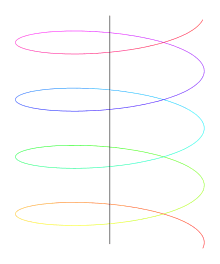Chasles' theorem (kinematics)

In kinematics, Chasles' theorem says that the most general rigid body displacement can be produced by a translation along a line (called its screw axis) followed (or preceded) by a rotation about that line.[1][2]
History
The proof that a spatial displacement can be decomposed into a rotation and slide around and along a line in space is attributed to Michel Chasles in 1830.[3] Recently the work of Giulio Mozzi has been identified as presenting a similar result in 1763.[4][5]
Proof
An elementary proof of Chasles theorem was given by E. T. Whittaker in 1904.[6] Suppose A is to be transformed into B. Whittaker suggests that line AK be selected parallel to the axis of the given rotation, with K the foot of a perpendicular from B. The appropriate screw displacement is about an axis parallel to AK such that K is moved to B. The method corresponds to Euclidean plane isometry where a composition of rotation and translation can be replaced by rotation about an appropriate center. In Whittaker's terms, "A rotation about any axis is equivalent to a rotation through the same angle about any axis parallel to it, together with a simple translation in a direction perpendicular to the axis."
References
- ↑ Kumar, V. "MEAM 520 notes: The theorems of Euler and Chasles". University of Pennsylvania. Retrieved 6 August 2014.
- ↑ Heard, William B. (2006). Rigid Body Mechanics. Wiley. p. 42. ISBN 3-527-40620-4.
- ↑ Chasles, M. (1830). "Note sur les propriétés générales du système de deux corps semblables entr'eux". Bulletin des Sciences Mathématiques, Astronomiques, Physiques et Chemiques (in French) 14: 321–326.
- ↑ Mozzi, Giulio (1763). Discorso matematico sopra il rotamento momentaneo dei corpi (in Italian). Napoli: Stamperia di Donato Campo.
- ↑ Ceccarelli, Marco (2000). "Screw axis defined by Giulio Mozzi in 1763 and early studies on helicoidal motion". Mechanism and Machine Theory 35: 761–770.
- ↑ E. T. Whittaker (1904) A Treatise on Analytical Dynamics of Particles and Rigid Bodies, p. 4, at Google Books